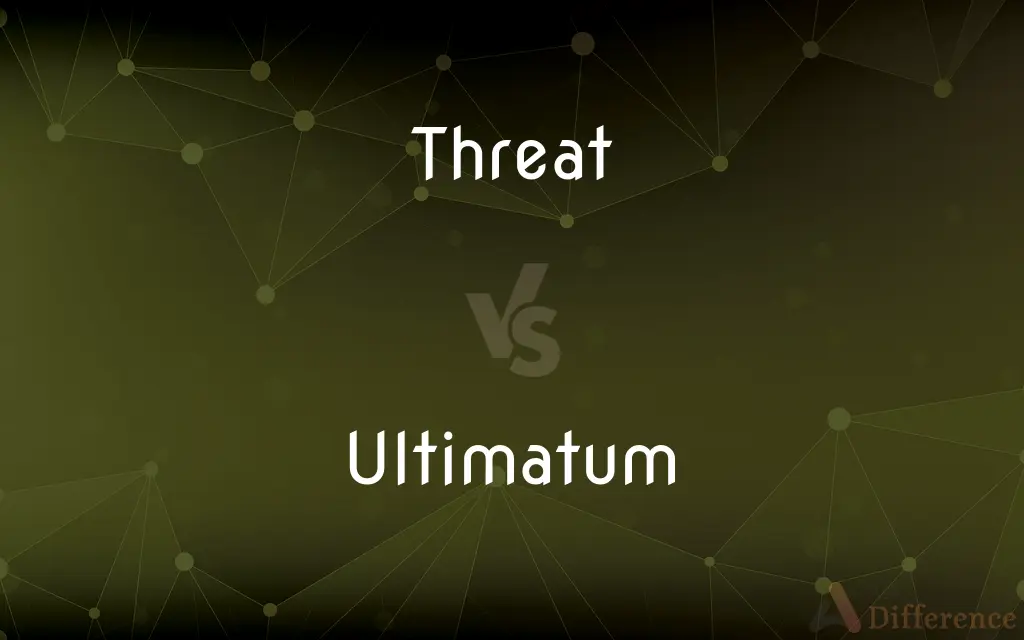Threat vs. Ultimatum — What's the Difference?
By Tayyaba Rehman & Fiza Rafique — Updated on April 25, 2024
A threat is a declaration of intent to cause harm or loss, while an ultimatum is a final demand that, if not met, results in consequences.

Difference Between Threat and Ultimatum
Table of Contents
ADVERTISEMENT
Key Differences
A threat typically involves a statement of intent to harm or penalize someone if specific conditions are not met, focusing on creating fear or compliance. Whereas an ultimatum, although similar in its conditional nature, is often a final statement in a negotiation, presenting the last terms offered before serious consequences are enacted.
Threats can be vague or explicit and may not always specify the conditions for avoidance, emphasizing the intimidatory impact. On the other hand, an ultimatum is clear and specific, detailing the conditions that must be met to avoid the negative consequences, highlighting its role in decision-making processes.
While threats are generally seen as aggressive and hostile, meant to elicit fear for manipulation or control, ultimatums are typically used as a strategic move in negotiations, signifying a critical point where further compromise is no longer possible.
Threats can be used in various contexts, from personal interactions to international relations, often as a tool to gain an upper hand or enforce action. In contrast, ultimatums are usually part of structured negotiations, used to push for a decision when all other options seem exhausted.
Lastly, understanding the psychological impact of threats involves recognizing their potential to induce stress or fear. Ultimatums, while also stressful, function more as a catalyst for decision-making, forcing the issue to a conclusion.
ADVERTISEMENT
Comparison Chart
Definition
A statement of intent to harm or penalize
A final demand that triggers consequences if not met
Purpose
To intimidate or manipulate
To conclude negotiations with a final offer
Connotation
Aggressive, hostile
Strategic, decisive
Clarity
Can be vague
Always specific and clear
Context
Used in various contexts from personal to global
Typically used in formal negotiations
Compare with Definitions
Threat
Statement of harm.
He issued a threat that he would reveal the secret if not compensated.
Ultimatum
Final demand.
She gave an ultimatum to resolve the issue by Friday or face legal action.
Threat
Intimidation tactic.
The manager's threat of firing employees curbed absenteeism.
Ultimatum
Last offer.
The union issued an ultimatum for better wages or a strike would follow.
Threat
Coercive declaration.
They faced a threat of eviction for late rent payments.
Ultimatum
Condition for action.
The company’s ultimatum was clear. improve performance or leave.
Threat
Warning of consequences.
The teacher’s threat of extra homework kept the class quiet.
Ultimatum
Decisive challenge.
His ultimatum to either commit or break up marked a turning point in their relationship.
Threat
Hostile intention.
The rival issued a threat to take over the business.
Ultimatum
Negotiation tool.
The diplomat presented an ultimatum as the last effort for peace.
Threat
A threat is a communicated intent to inflict harm or loss on another person. Intimidation is widely observed in animal behavior (particularly in a ritualized form) chiefly in order to avoid the unnecessary physical violence that can lead to physical damage or the death of both conflicting parties.
Ultimatum
An ultimatum (; Latin for 'the last one') is a demand whose fulfillment is requested in a specified period of time and which is backed up by a threat to be followed through in case of noncompliance (open loop). An ultimatum is generally the final demand in a series of requests.
Threat
An expression of an intention to inflict pain, harm, or punishment.
Ultimatum
A final offer or demand made by one party to another, especially in diplomatic negotiations, expressing or implying the threat of serious consequences or the breakoff of relations if the terms are not accepted.
Threat
An indication of impending danger or harm
A threat of frost in the air.
Ultimatum
A final statement of terms or conditions made by one party to another, especially one that expresses a threat of reprisal or war.
Threat
One that is regarded as a possible source of harm or danger
Viewed the stranger as a threat to the community.
Ultimatum
A final proposition, concession, or condition; especially, the final propositions, conditions, or terms, offered by either of the parties in a diplomatic negotiation; the most favorable terms that a negotiator can offer, the rejection of which usually puts an end to the hesitation.
Threat
The condition of being in danger or at risk
Under threat of attack.
Ultimatum
A final demand, the rejection of which may lead to a resort to force or other compelling action by the party presenting the ultimatum. In international diplomacy, an ultimatum may be used as by the demanding country as a signal to other countries that it gave the other country a seemingly reasonable opportunity to avoid a war; in this way, the demanding country may seek to avoid responsibility for starting a war.
Threat
To threaten.
Ultimatum
A final peremptory demand
Threat
An expression of intent to injure or punish another.
Threat
An indication of potential or imminent danger.
Threat
A person or object that is regarded as a danger; a menace.
Threat
(transitive) To press; urge; compel.
Threat
To threaten.
Threat
(intransitive) To use threats; act or speak menacingly; threaten.
Threat
The expression of an intention to inflict evil or injury on another; the declaration of an evil, loss, or pain to come; menace; threatening; denunciation.
There is no terror, Cassius, in your threats.
Threat
To threaten.
Of all his threating reck not a mite.
Our dreaded admiral from far they threat.
Threat
Something that is a source of danger;
Earthquakes are a constant threat in Japan
Threat
A warning that something unpleasant is imminent;
They were under threat of arrest
Threat
Declaration of an intention or a determination to inflict harm on another;
His threat to kill me was quite explicit
Threat
A person who inspires fear or dread;
He was the terror of the neighborhood
Common Curiosities
Can threats be legal?
Threats can be illegal if they involve coercion, blackmail, or induce unreasonable fear.
What should one consider before giving an ultimatum?
Consider the readiness to follow through with the consequences and the potential loss of relationship or negotiation leverage.
How do threats and ultimatums differ in purpose?
Threats are used to create fear or compliance, while ultimatums are meant to push a decision or conclusion in negotiations.
Are ultimatums effective in negotiations?
Ultimatums can be effective but risky; they might force a resolution or end discussions if the other party chooses to withdraw.
What is an ultimatum?
An ultimatum is a final demand or proposal that if rejected, results in the termination of an ongoing relationship or the initiation of a punitive action.
Is issuing an ultimatum considered aggressive?
While ultimatums can be seen as aggressive, they are generally viewed as part of strategic decision-making processes.
What is a threat?
A threat is a declaration indicating an intention to inflict harm or other adverse action on someone if they do not comply.
How should one respond to a threat?
Responses can vary from compliance, negotiation, seeking help, or legal action depending on the severity and context of the threat.
Can ultimatums be part of healthy communication?
Ultimatums can be part of healthy communication if they are clear, justified, and used as a last resort after all other options have been explored.
What psychological effects do threats have?
Threats can induce anxiety, fear, and can sometimes lead to compliance or defiance, depending on the individual's response.
How can ultimatums impact relationships?
Ultimatums can either lead to quick resolutions or could damage relationships if seen as too coercive or if the recipient feels cornered.
What are some examples of non-violent threats?
Non-violent threats can include threats of legal action, threats of disclosing information, or threats of financial penalties.
What makes an ultimatum effective?
Clarity, the legitimacy of the demand, the feasibility of the conditions, and the readiness to act on the consequences make an ultimatum effective.
Can threats be made in a professional setting?
While threats are generally unprofessional, some forms of threats like warning of job termination based on performance can occur within legal boundaries.
How can one mitigate the harshness of an ultimatum?
Presenting an ultimatum respectfully, providing reasonable time for response, and showing willingness to engage in further dialogue can mitigate its harshness.
Share Your Discovery

Previous Comparison
Lawsuit vs. Case
Next Comparison
Storyline vs. PlotAuthor Spotlight
Written by
Tayyaba RehmanTayyaba Rehman is a distinguished writer, currently serving as a primary contributor to askdifference.com. As a researcher in semantics and etymology, Tayyaba's passion for the complexity of languages and their distinctions has found a perfect home on the platform. Tayyaba delves into the intricacies of language, distinguishing between commonly confused words and phrases, thereby providing clarity for readers worldwide.
Co-written by
Fiza RafiqueFiza Rafique is a skilled content writer at AskDifference.com, where she meticulously refines and enhances written pieces. Drawing from her vast editorial expertise, Fiza ensures clarity, accuracy, and precision in every article. Passionate about language, she continually seeks to elevate the quality of content for readers worldwide.
















































